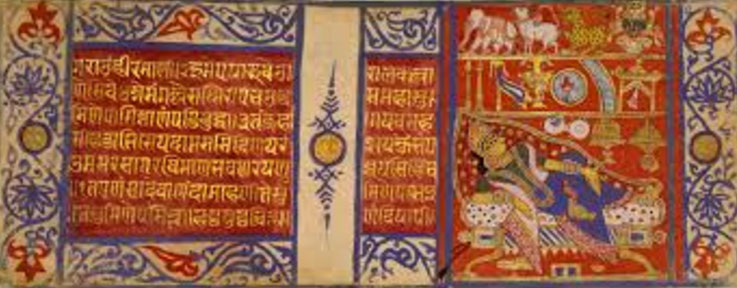Jain Paintings
Historical Background
 |
By Shri S. M. Nawab
Jain Paintings During Medieval Era
There are few traces of medieval wall-paintings left in western and Central India, and, therefore, the Panchatantra stories painted on the mandapa of the Vishnu temple at Madanpur, District Lalitapur, Uttar Pradesh, known as Chota Kachahari, are of special interest. The temple was built in the reign of Madana Varma (1130-1165 A.D.), and the paintings were added probably shortly after the completion of the building. Dr. Stella Kramrisch, while describing these paintings, observes in a note that they are more related to Western Indian minature paintings of twelfth to fourteenth century. Their chief interest lies in the angularity of drawing, pointed nose and the protrusion of farther eye into space. These features, together with the characteristic mode of wearing bun-like coiffeur, well trimmed beard and the conventional treatment of trees, birds and animals, share with the Western Indian miniatures of 12th to 14th century.
 |
In the tenth and eleventh centuries wall-paintings seem to have been a common mode of artistic expression in South India. It is remarkable that most of such paintings come from the Digambara Jain temples, and also from Hindu temples. The wall paintings in the Digambara Jain temple at Tirumalai are datable on the strength of inscriptions between the tenth and fourteenth centuries. On the stylistic grounds, however, the Tirumalai wall-paintings may belong to the 11th or 12th century.
Two layers of paintings are visible at Tirumalai. They represent the Devatas and Kimpurusas flying in the clouds, the Devas marching in a line towards the Samavasarana, the Gandharvas and heavenly nymphs, a Deva standing amidst flowers, and a row of nuns clad in white. In the second layer, which is considerably later than the first and may belong to the end of the12th century, there is the representation of a Jain monk seated on a cushion facing another monk; another scene depicts Digambara monks preaching to a lady who is offering them food; and a third depicts a four-armed, and three-eyed deity, possibly Indra.
All the paintings in the interior are on black ground, white different ochres, terraverte and grey earths fill the outline of the figures. There is no attempt at modelling, though the colour tones are the same as at Ajanta.
-----------------------------------------------------
Mail to : Ahimsa Foundation
www.jainsamaj.org
R13111